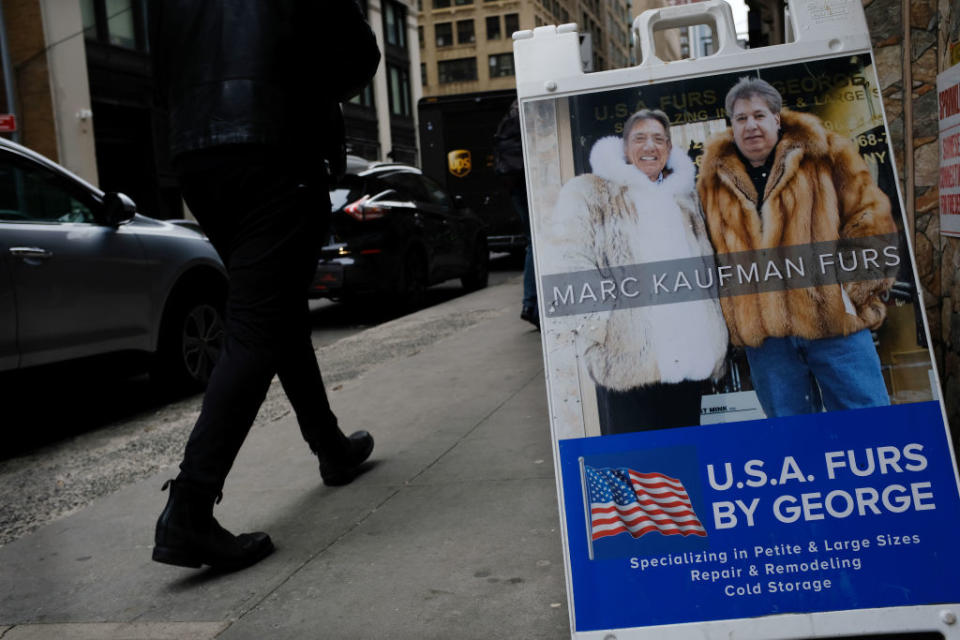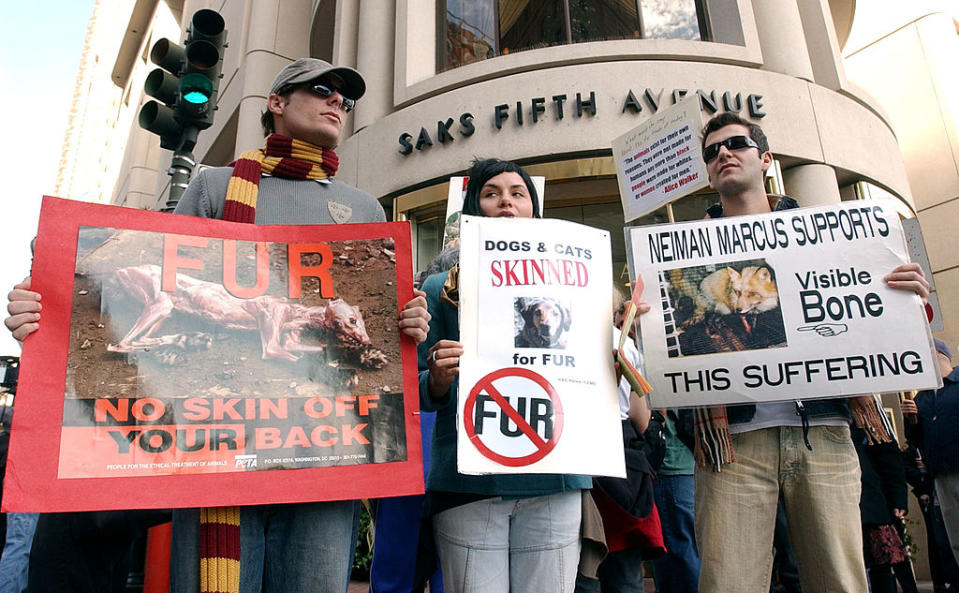Fur Industry Has ‘Good, Long and Healthy Future’ Ahead, CEO Says

Fur sales are in steady decline, but according to the head of the industry’s international trade organization, it has little to do with animal rights activism or changing mores about killing animals.
Instead, Mark Oaten, CEO of the International Fur Federation, says the chief culprits are a declining Chinese economy, Russia’s invasion of Ukraine, global warming and Covid, which on top killing 7 million people worldwide, resulted in the culling of 17 million mink when the virus infected 200-plus farms in Denmark and cost the industry more than $2 billion.
More from Sourcing Journal
Mongolian Cashmere Exposé Puts Luxury Giants in the Hot Seat
PETA Questions How Selling Down-Stuffed Clothing Aligns With Lululemon's 'Core Values'
“I understand why the government panicked that way. The rest of Europe took a different view on it, but I don’t overly criticize them because I realize there were tough choices to be made,” Oaten told Sourcing Journal. “That was just a bad call.”
Oaten said fur was a $33 billion business in 2018, down from a near record-high of $44 billion in 2017. The slowest growth rate for the Chinese economy since the fall of the Berlin Wall began fur’s downfall in 2018, and by the time Covid erupted, it had fallen below $20 billion.
“We came out of Covid and had a huge boom of what the luxury industry calls ‘revenge buying’,” said Oaten, who estimates fur’s current global value at $20 billion. “Then, we saw the market dip again because a lot of our business is done in and around Russia.”
Russia is also the world’s largest source of prized sable fur, with some coats going for as much as $100,000.
Oaten blames even warmer weather ahead of the animal rights movement for fur’s recent decline.
“If we get a very mild winter in New York or Beijing, that has much more of an impact on our sales than a PETA campaign,” Oaten said. “The one counter I would say to that is that if PETA and others persuade a Macy’s or Bloomingdale’s to drop fur, then obviously that reduces the opportunity for the consumer to buy at those shops, but it doesn’t stop the consumer from wanting [fur].”
Nick Pologeorgis, whose father opened Pologeorgis Furs in the Garment District of Manhattan in 1960, said activists have been successful in “bullying” department stores out of carrying furs. He has a storefront in Greenwich, Connecticut, and an eighth-floor showroom on 29th Street in Manhattan.
“The consumer really hasn’t changed their mentality; it’s the stores that don’t want to be bullied,” Pologeorgis told Sourcing Journal. “I have people coming in from all over the country now that can’t find [fur] within their normal channels.”
Simon Cheisomaleitnis at Furs by George said the industry misses the days before the anti-fur movement compelled virtually every department store besides Dillard’s to go fur-free.

“No one’s doing the volume they did back then. If they’re doing a million dollars a year [now], they were doing $5 or $6 million back then,” Cheisomaleitnis told Sourcing Journal.
Cheisomaleitnis traces the decline of fur to globalization of the 1980s.
“The Koreans were allowed to enter the market and undercut us with labor drastically,” he said. “So a coat that would cost us $5,000 to make, they would sell retail for $3,500. That really put the nail in the coffin.”
Cheisomaleitnis said these days he’s seeing a change in the fur coat buyer. What used to be a 99 to 1 female-to-male ratio of coat customers is now closer to 50/50.
“We’re shooting our new catalog and we’re having male models do it,” he said.
Pologeorgis said he’s seeing female customers migrate toward smaller fur pieces, as well as throw pillows and other housewares. He said coat wearers gravitate toward shearlings, which is to say sheepskin with the wool still attached. Macy’s and many other department stores that have parted ways with fur, still carry shearling, even though it, too, requires killing the animal. The use of the animal for food in addition to its skin allows shearling to be called “ethically raised.”
Pologeorgis sees that distinction as hypocritical, along with faux furs made from eco-unfriendly polyester, modacrylic and acrylic fibers.
“[Anti-fur activists] can say whatever they want, they’re destroying the environment slowly,” Pologeorgis said, questioning the “sustainability” of microfiber-shedding faux fur products.
Oaten said one of his biggest failures is not promoting fur as sustainable. He contends fur is a friend to the planet, and says many trapped animals likely would be culled according to government conservation plans. “It really bugs me when you see a brand like Versace saying they’re giving up fur because they want to be more sustainable and then they switch to a plastic, fake alternative,” he said.
Anti-fur advocates counter that a majority of the harvested animals are caged on farms where pollution and overfeeding create a higher carbon footprint. Richard Bissett with Respect for Animals, Britain’s leading anti-fur organization, calls fur’s conservationist play a desperate canard.
“Having lost the argument on animal welfare, the fur industry tries to present itself as ‘green’,” Bissett told Sourcing Journal. “However, this amounts to nothing other than greenwashing of what actually is a resource-intensive, highly polluting industry, which has little regard for its impact on biodiversity and the environment—and no plan to reduce this impact.”
Oaten said animal welfare activists cause fashion executives to “panic,” but he insists the anti-fur movement is not the reason for falling sales.
“LVMH are big supporters, Fendi, Dior and others report anecdotally very strong sales in New York,” he said. “So…the very high luxury end seems to be doing really well. I would say the mid-market level is struggling a little bit, but that’s probably due to people having less cash in their pockets.”

Bissett doesn’t buy that take either. Respect for Animals’ research shows that more than 70 percent of people in North America and Europe oppose killing animals for their fur, including 71 percent in the U.S. and 79 percent in Canada. Russia was the only country polled that did not have a majority opposing fur at 48 percent with France a close second at 51 percent.
“There are strong ethical reasons for doing this due to the inherent cruelty involved in the fur industry, but also it makes sense for brands to go fur free for economic reasons: consumers don’t want fur products,” Bissett said. “Ultimately, though, we need legislators to take the key step to outlaw fur farming and fur trapping, as well as the trade in these cruel and unnecessary products.”
One major legislative victory for the anti-fur movement came this year when California enacted a statewide ban on the manufacture and sale of new furs that previously only applied to the cities of Los Angeles and San Francisco. In 2019 there were attempts to pass similar bills in New York City and at the state level, but both ultimately failed due to strong cultural connections to fur in the Black and Jewish communities, and, as Cheisomaleitnis points out, perhaps also due to the New York’s long fur history and a longtime workforce that still exceeds 1,000. He questions what would happen to people who work in the fur business if the industry dries up.
A bill before the New York state assembly since March 2021, sponsored by Democratic Senator Jabari Brisport of Brooklyn’s 25th Senate District, has yet to make it out of committee.
Cheisomaleitnis, whose family has been in the fur business for more than 75 years, said Furs by George had planned on opening a warehouse in California before the statewide ban was enacted.
“As much as I can understand both sides, it’s just slowly, slowly dying,” Cheisomaleitnis said. Boutiques that take individual orders will soon all be that’s left of fur in the Garment District, he added. But running stores out of business won’t curb the global demand for fur, as stores selling cheaper versions from China will take his place.
Bissett said the European Union is on the fast track to going fur-free. There, 1.5 million signatures were recently collected asking the government to forbid fur products in all member nations. In Lithuania, a bill to ban fur harvesting passed its second reading. Europe is the destination for much of the world’s imported fur.
Bissett said that government regulations aside, economic forces are driving fur farmers to grow strawberries or brew beer to make ends meet, another sign of “how outdated the fur industry really is.”
Saga Furs recently held an auction, the largest of its kind in the world. Of the 5 million mink pelts and half-a-million fox and finnraccoon skins up for bid, 76 percent of the former were purchased and 60 percent of the others for $101 million total, down from $132 million at the auction three months earlier.
“Shockingly, there were over 5 million skins offered at just one auction, which is a shocking number, and further highlights that these animals are cruelly raised or trapped and then killed just for a product we don’t really need,” Bissett said. “Those of us who campaign across the cruel fur trade do so in the full knowledge that we are working to put ourselves out of a job. That’s something we would happily take if it meant a fur-free world.”
Oaten said he believes people will still be wearing furs in 50 years.
“As long as we continue to keep our standards high, and if we can try to get our messaging across about it being a sustainable item, as opposed to a fast fashion item, I think we have a good, long and healthy future,” he said. “But if I want to be critical of my organization and myself, it’s that we’ve struggled with that message at times.”

